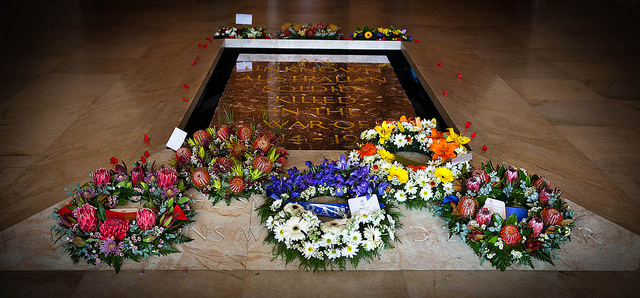Plans to honour an unknown Australian soldier were first put forward in the 1920s, but it was not until 1993 that one was at last brought home. To mark the 75th anniversary of the end of the First World War, the body of an unknown Australian soldier was recovered from Adelaide Cemetery near Villers-Bretonneaux in France and transported to Australia. After lying in state in King’s Hall in Old Parliament House, the Unknown Australian Soldier was interred in the Hall of Memory on 11 November 1993. He was buried in a Tasmanian blackwood coffin, on which were placed a bayonet and a sprig of wattle. Soil from the Pozières battlefield in France was scattered in his tomb.
Architects Tonkin Zulaikha Harford, in collaboration with artist Janet Laurence, designed the Tomb of the Unknown Australian Soldier and the Four pillars sculpture. The tomb lies directly beneath the dome, where the souls of the dead are shown ascending to heaven. The tomb is covered with a slab of red marble inscribed with gilded lettering, colours that subtly mirror those of the dome. The slab is set into a recess of black granite, suggesting the grave within the earth. A sloping marble border sets the tomb apart from the floor, marking a physical division between the living and the resting place of sacred sacrifice. The inscription on the tomb reads, “An unknown Australian soldier killed in the war of 1914–1918”. At the head of the tomb is inscribed “Known unto God” and at the foot, “He is all of them and he is one of us.”

